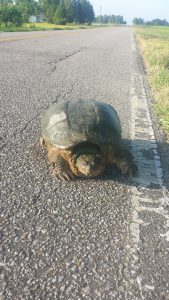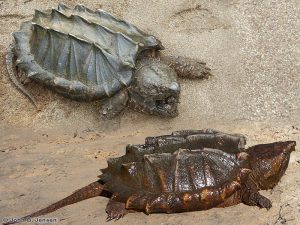There are a couple of things you learn when working with youth in turtle education.
1) ALL turtles are snapping turtles
2) Snapping turtles are dangerous
I grew up in a sand hill area of Pensacola and we found box turtles all of the time. We had one as a “pet” and his name was “Snappy”. Oh, I forgot… all turtles are males.
That said, others are well aware of this unique species of turtle in our state. It does not look like your typical turtle. (1) They are large… can be very large – some male alligator snappers have weighed in at 165 lbs.! (2) Their plastron is greatly reduced, almost not there. Because of this their legs can bend closer to the ground and walk more like dogs than other turtles do. We call this cursorial locomotion. Snappers are not cursorial, but they are close, and because of this can move much faster across land. (3) Their carapace is almost square shaped (versus round or oval) and have large ridges making them look like dinosaurs. (4) They have longer tails than most turtles, some species have scales pointing vertically making them look even more like dinosaurs. Scientists have wondered whether this unique reduced plastron-better locomotion design was the original for turtles (and they lost it), or they are the “new kids on the block”. The evidence right now suggests they are “the new kids”.

The relatively smooth shell of a common snapping turtle crossing a highway in NW Florida.
Photo: Libbie Johnson
And of course, there is the “SNAP”. These are very strong animals who seem to crouch and lunge as they quickly SNAP at potential predators – as quickly as 78 milliseconds/bite. I remember once stopping on a rural highway to get one out of the road. I grabbed it safely behind the nape and near the rear. That sucker crouched and snapped, and I could hardly hold on. I was amazed by its strength. It did not understand I was trying to help. You do need to be careful around these guys.
In Florida, we have two species of snapping turtles; the common and the alligator. They look very similar and are often confused (everyone seen is called an alligator snapper). There are couple of ways to tell them apart.
1) The alligator snapper has a large head with a hooked beak.
2) The alligator snapper’s carapace is slightly squarer and has three ridges of enlarged scales that make it look “spiked”; where the common snapper lacks these.
3) The tail of the common snapper has vertical “spiked” scales; which the alligator lacks.
4) And the textbook range of the alligator snapper is the Florida panhandle. Basically, if you are south or east of the Suwannee River, it should not be around – you are seeing the common.
As the name implies, the common snapper (Chelydra serpentina) is found throughout the state – except the Florida Keys. There are actually two subspecies; the Common (C. serpentia serpentina) which is found west of the Suwannee River and the Florida Snapper (C. serpentina osceola). This species uses a wide range of habitats. They have been found in small creeks, ponds, floodplain swamps, wet areas of pine flatwoods, and on golf courses.
These are very mobile turtles, often seen crossing highways looking for nesting locations, dispersing to new territory, or their pond has just dried up and they need a new one. Interestingly they have an expanded diet. Most think of snapping turtles as fish eaters, but common snappers are known to consume large amounts of aquatic plants and invertebrates.
Like all turtles, snappers must find high-dry ground for nesting. Nesting begins around April and runs through June. In south Florida, nesting can begin as early as February. They select a variety of habitats and typically lay 2-30 eggs deep in the substrate. These incubate for about 75 days and the temperature of the egg determines its sex; warmer eggs produce females. Nest predation is a problem for all turtles, snappers are not exempt from this. Raccoons are the big problem, but fish crows, fox, and possibly armadillos also dig up eggs. Many adults have been found with leeches. Turtles are known to live long lives. Data suggests common snappers reach 50 years of age.
Alligator snappers (Macrochelys temminckii) are the big boys of this group. Where the common snapper’s carapace can reach 1.5 feet, the alligator snapper can reach 2.0. (that’s JUST the shell). As mentioned, this animal is found in the Florida panhandle only. It is a river dweller and prefers those with access to the Gulf of Mexico. They appear to have some tolerance of brackish water. One alligator snapper near Mobile Bay AL had barnacles growing on it. Evidence suggest they do not move as much as common snappers and stay in the river systems where they were born. There are three distinct genetic groups: (1) the Suwannee group, (2) the Ochlocknee/Apalachicola/Choctawhatchee group, and (3) the Pensacola Bay group.
This animal is more nocturnal than their cousin and are not seen very often. They are basically carnivores and known to feed on fish, invertebrates, amphibians, birds, small mammals, reptiles, small alligators, and acorns are common in their guts. This species possesses a long tongue which they use as a fishing lure to attract prey.
Alligator snappers have a much shorter nesting season than most turtles; April to May. And, unlike other turtles, only lay one clutch of eggs per season. They typically lay between 17-52 eggs, sex determination is also controlled by the temperature of the incubating egg, and they may have strong site fidelity with nesting. Male alligators are very aggressive towards each other in captivity. This suggests strong territorial disputes occur in the wild. These live a bit longer than common snappers; reaching an age of 80 years.
Though still common, both species have seen declines in their populations in recent years. Dredge and fill projects have reduced habitat for the common snapper. Dams within the rivers and commercial harvest have impacted alligator snapper numbers. The alligator snapper is currently listed as an imperiled species in Florida and is a no-take animal (including eggs). Because the common snapper looks so similar, they are listed as a no-take species as well.
Both of these “dinosaur” looking creatures are amazing and we are lucky to have them in our backyards.
References
Meylan P.A. (Ed). 2006. Biology and Conservation of Florida Turtles. Chelonian Research Monographs No.3, 376 pp.
FWC – Freshwater Turtles
https://myfwc.com/wildlifehabitats/wildlife/freshwater-turtles/.
- Tips for Bear Encounters this Fall - November 10, 2025
- Pensacola Bay Invasive Species Summer Survey 2025 - November 3, 2025
- Our Environment: Part 24 – Our Changing Climate - November 3, 2025

